Via a posting in the Jinbonuri discussion board (meant to upset the DPRK-minded who hang out there) I learned about a recent KBS program called KBS Report: North Korea in 2006 - is it Being taken over by Chinese capital.
Looking at the five themes introduced on the program webpage, it is mainly about the ongoing encroachment of Chinese products and capital into DPRK and its increasing economic dependence on China.1. What's happening in the downstream of Yalu, between Dandong and Sinuiju?
2. What's being exchanged in North Korean markets
3. Why have the Chinese products taken over the North Korean market?
4. Has China seized only the North Korean consumer market?
5. What does the increasing economic dependence of the North Korean economy on China mean for Korean peninsula? Not being able to see the program as it's not available on the site "due to copyright issues", the best and most interesting piece of it that I've gotten hold of are the numerous screen captures linked in the Jinbonuri posting, of which I'll reproduce and translate some here, with some additional info like the interviewee's home place which doesn't show in these captures. Several of the captions I've translated below are from pics that I don't show here; they don't contain any additional info besides the interview caption.
Good background to what these people tell, especially the Pyongyang woman, is Andrei Lankov's "Another Korea" column Market Forces:
[...] The old socialist state-managed economy is almost dead, and the ongoing economic activity is largely private in nature. But the new North Korean capitalism of dirty market places, charcoal trucks, and badly dressed vendors with sacks of merchandise on their backs demonstrates one surprising feature: it has a distinctly female face. Indeed, women are overrepresented in the growing North Korean post- Stalinist economy. [...] 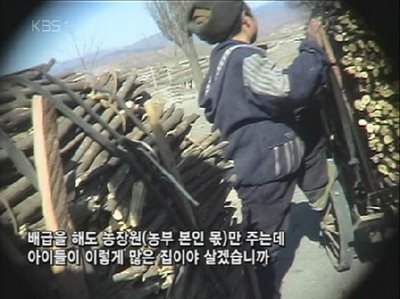
Citizen of Northern Hamgyong:
Even if there are rations, they are given only to farm members. How can a family with this many children survive?
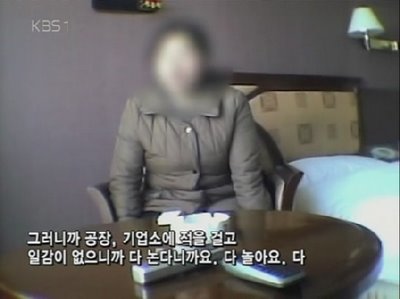
Factories, companies, nothing is operating.
So, all the factories and companies are idle because there are no orders to do. All the places are idle, all.
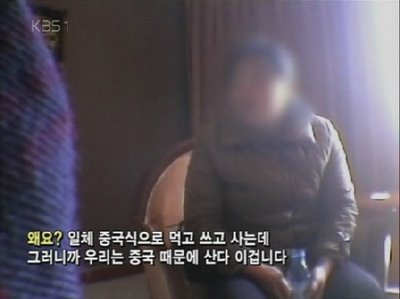
Pyongyang citizen:
[Previous screen] The common people's perception is that we can live because of China.
Why? -Because it's Chinese that we eat and use and live on. So that's why we can live because of China.
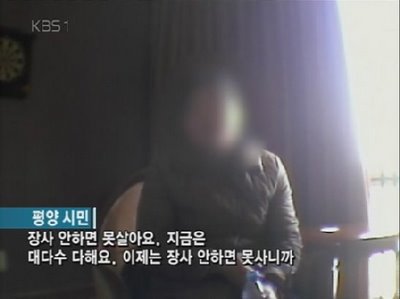
There's no way to live without trading (changsa). Nowadays almost everyone is doing it. Now you can't live if don't trade.
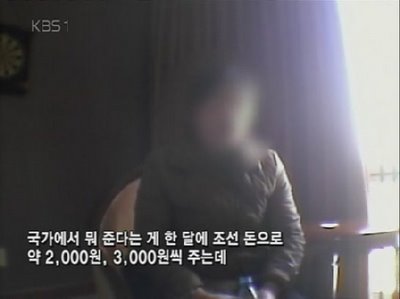
What you're supposed to get from the government is some 2000, 3000 won a month, -
but you can't live on that in Pyongyang.
[For comparison, monthly wages in the Kaesong plant have been reported to be around 6000 won, and there've been reports of 4000-4500 won as well.]
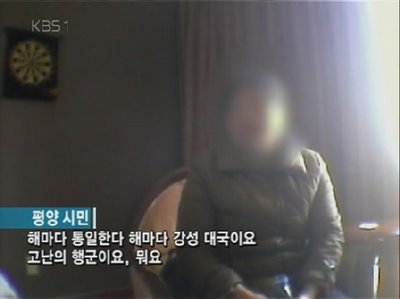
Every year it's unification, it's strong and great nation, it's the arduous march and all that -
and let's just endure, let's overcome the difficulties, it's been this kind of propaganda for two years now.
But now there's none of that any more. They [authorities?] let us do what we want.
All I think is how I could succeed in trading and feed our family. I have no expectations [on the government?].
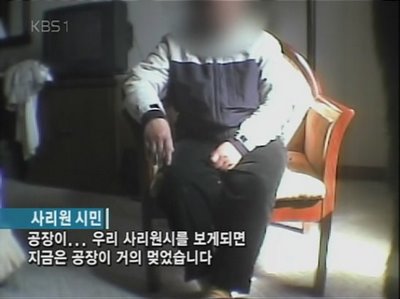
(Sariwon citizen)
Factories... In our Sariwon factories are almost at halt.
This year there's been no rations, and last year on October 10 (Worker's Party foundation anniversary) -
And after that at the end of the year, on February 16 (Kim Jong-il's birthday), and on April 15 (Kim Il-sung's birthday) a bit was given.
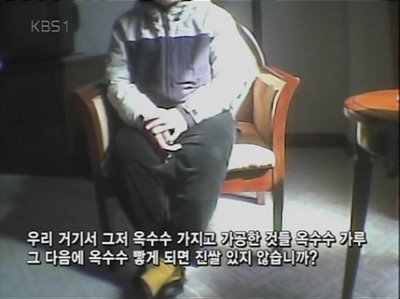
Cooked rice is eaten on children's birthdays and on festive days.
We have corn (oksusu) there, and foodstuffs made of that, corn flour and chinssal [?] made of ground corn.
Vegetables (namul) is put in there (to cook porridge). Poor families eat like that.

Have you seen rice or fertilizers from South Korea (Namchosôn)?
Is it given as rations?
I haven't gotten any rations, we buy all our food.
There are (rice) sacks and fertilizer where it's written Republic of Korea (Taehan Min'guk). We buy that, from the marketplace (changmadang).

Because there are no materials. We need to import all the raw materials.
But are there any dollars? Is there economy to speak of? (Or, "DPRK is broke, right?", kyôngjega issûmnikka?). So, nothing is functioning. |
Categories at del.icio.us/hunjang: DPRK ∙ minjok ∙ women-men |













Comments to note "KBS interviews with North Koreans" (Comments to posts older than 14 days are moderated)
So, can we say conclusively that while KoguryO was definitely not a regional government of Han Dynasty China, the DPRK possibly is an economic sub-unit of the PRC? Another case of history not repeating itself.
Write a Comment